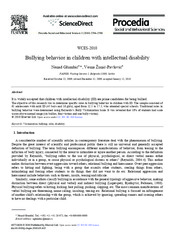Приказ основних података о документу
Bullying behavior in children with intellectual disability
| dc.creator | Glumbić, Nenad | |
| dc.creator | Žunić-Pavlović, Vesna | |
| dc.date.accessioned | 2021-06-09T13:35:21Z | |
| dc.date.available | 2021-06-09T13:35:21Z | |
| dc.date.issued | 2010 | |
| dc.identifier.issn | 1877-0428 | |
| dc.identifier.uri | http://rfasper.fasper.bg.ac.rs/handle/123456789/391 | |
| dc.description.abstract | It is widely accepted that children with intellectual disability (ID) are prime candidates for being bullied. The objective of this research was to determine specific roles in bullying behavior in children with ID. The sample consisted of 61 adolescents with mild ID (45 boys and 16 girls), aged from 12.5 to 17.5, who attended special schools. Traditional roles in bullying behavior were determined using Reynolds's Bully Victimization Scale. It was revealed that 18% of students had scale scores above normal range (six bullies, four victims and one bully-victim). | en |
| dc.publisher | Elsevier Science bv, Amsterdam | |
| dc.rights | openAccess | |
| dc.source | Innovation and Creativity in Education | |
| dc.subject | Victimization | en |
| dc.subject | bullying | en |
| dc.subject | roles | en |
| dc.subject | disability | en |
| dc.title | Bullying behavior in children with intellectual disability | en |
| dc.type | conferenceObject | |
| dc.rights.license | ARR | |
| dc.citation.epage | 2788 | |
| dc.citation.issue | 2 | |
| dc.citation.other | 2(2): 2784-2788 | |
| dc.citation.spage | 2784 | |
| dc.citation.volume | 2 | |
| dc.identifier.doi | 10.1016/j.sbspro.2010.03.415 | |
| dc.identifier.fulltext | http://rfasper.fasper.bg.ac.rs/bitstream/id/421/388.pdf | |
| dc.identifier.scopus | 2-s2.0-77957714408 | |
| dc.identifier.wos | 000282002802130 | |
| dc.type.version | publishedVersion |


